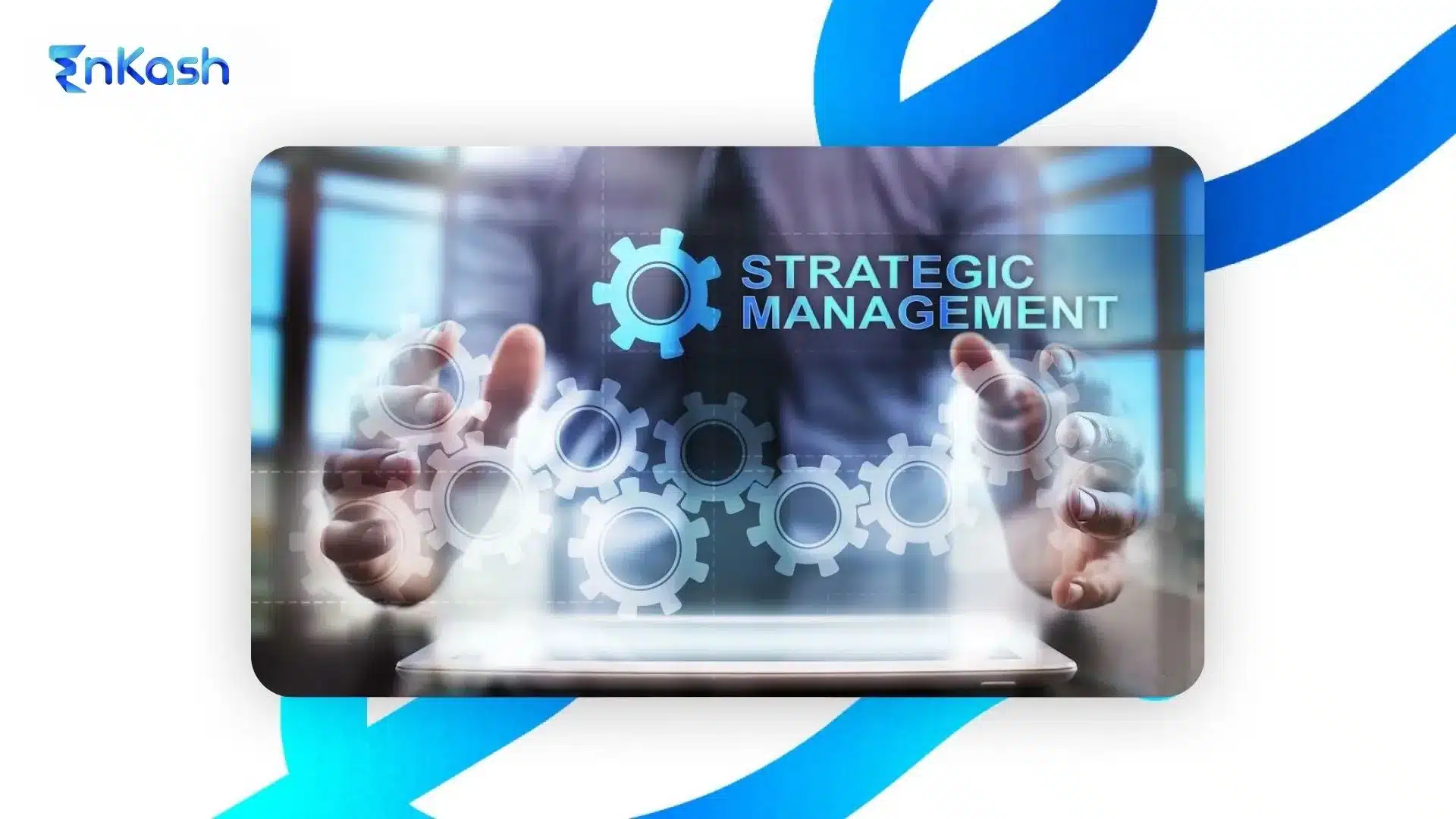What is Strategic Management?
What is strategic management? It’s a question many business leaders ask when they start thinking about long-term direction. At its core, it is the practice of defining clear goals, designing strategies to achieve them, and then making sure those strategies are carried out effectively.
The strategic management meaning goes beyond routine planning. It is a structured process that combines analysis, decision-making, and implementation. It connects the larger purpose of an organization with the day-to-day actions of its people. In simple terms, it helps a business understand where it stands, where it wants to go, and how it will reach that destination.
When asked, What do you mean by strategic management, the answer lies in its dual role. It involves both creating strategies and ensuring their execution. It is not just about designing a plan on paper. It is about aligning resources, managing risks, and adjusting directions when conditions change.
The strategic management concept rests on clarity, adaptability, and focus. A company guided by strategic principles does not leave its growth to chance. It identifies opportunities, anticipates challenges, and builds the discipline to act in a coordinated way. This makes it possible to achieve results that are sustainable, not temporary.
In modern business, strategic thinking is no longer reserved for the top layer of management. It extends across departments and functions, making sure every unit contributes to the broader vision. This approach ensures that the organization moves forward as a unified whole, with strategy in management acting as the backbone of progress.
Why Strategic Management Matters Today
In business, nothing stays still for long. Markets shift, new competitors arrive, technologies reshape industries, and consumer preferences evolve in unexpected ways. To stay ahead, organizations need more than short-term fixes. They need a clear direction that guides every decision and helps them move with purpose. This is where Strategic Management plays a decisive role.
Strategic Management gives businesses a framework to think beyond immediate results and to prepare for future challenges. It helps leaders decide where to focus their energy, how to use their resources, and how to respond when the environment changes. Without it, companies risk moving in circles, reacting to events instead of shaping their own path.
In today’s context, Strategic Management matters because uncertainty has become a constant. Global supply chain disruptions, shifts in consumer behavior, regulatory reforms, and rapid digital adoption demand structured planning. Strategic choices taken now determine which businesses grow stronger and which fall behind.
This approach does not end with planning. It creates a continuous cycle of setting direction, making informed choices, implementing them across every level of the organization, and revisiting those choices as new realities emerge. Through this cycle, businesses develop resilience, sharpen their competitive edge, and build trust with stakeholders who expect clarity and consistency.
Strategic thinking has always been important, but its weight has grown in the current environment. Companies that embrace Strategic Management as an ongoing process are better positioned to achieve stability, growth, and long-term success.
Strategic Management Concept and Core Principles
Strategic Management Concept
The strategic management concept is built on the idea that business success depends on more than operational efficiency. It focuses on long-term planning, competitive positioning, and the ability to adjust to changes. Unlike routine management, which handles daily tasks, strategic management creates a roadmap for the future. It ensures that every action is tied to larger goals, making growth intentional rather than accidental.
Nature of Strategic Management
The nature of strategic management is dynamic. It adapts to the environment in which the business operates. Markets evolve, regulations shift, and technology reshapes industries. A static approach cannot survive these realities. Strategic management is forward-looking and flexible, giving organizations the ability to anticipate challenges and respond with agility.
Characteristics of Strategic Management
The characteristics of strategic management highlight what makes it distinct:
- It aligns every department and function with long-term objectives.
- It encourages decisions that balance risk and opportunity.
- It requires continuous monitoring of performance and external conditions.
- It builds value by focusing on strengths and addressing weaknesses.
- Strategic management is not a one-time task but an ongoing discipline.
Its principles guide leaders to make decisions that serve both immediate needs and future goals. By connecting purpose with execution, it lays the foundation for resilience and growth in any competitive landscape.
Objectives and Scope of Strategic Management
Objectives of Strategic Management
The objectives of strategic management provide a clear sense of direction for businesses. These objectives include:
- Defining a vision and mission that guides every decision.
- Achieving sustainable growth by exploring new opportunities.
- Building competitive advantage through differentiation or cost leadership.
- Aligning resources so they serve the highest priorities.
- Reducing risks by anticipating external threats and preparing responses.
- Ensuring long-term survival by staying relevant in changing markets.
- By meeting these objectives, strategic management helps organizations create stability while preparing for expansion.
Scope of Strategic Management
The scope of strategic management extends across different levels of decision-making. At the corporate level, it determines which industries or markets the business should operate in. At the business unit level, it decides how to compete within a chosen market. At the functional level, it shapes strategies for marketing, operations, finance, or human resources. Finally, at the operational level, it turns strategy into daily tasks.
This wide scope ensures that strategy is not confined to boardrooms. It flows into every activity of the organization, creating alignment from top to bottom.
What Strategic Management Includes
When asked what strategic management includes, the answer covers a complete cycle:
- Clarifying mission, vision, and long-term goals.
- Analyzing internal strengths and external opportunities.
- Formulating strategies that use resources wisely.
- Implementing plans through structure, culture, and people.
- Monitoring outcomes and making adjustments as required.
By combining all these elements, strategic management keeps an organization focused, prepared, and capable of delivering results that last.
Features of Strategic Management in Practice
Decision-Making Under Uncertainty
The features of strategic management become visible when choices must be made in uncertain conditions. Leaders rarely enjoy perfect information. Markets change, competitors shift tactics, regulations alter ground rules. Instead of guessing, strategic management offers a method to weigh risks, compare alternatives, and still move forward with conviction.
Integration Across Functions
Strategy succeeds when it breaks silos. Marketing cannot chase one agenda while finance pursues another. Operations cannot run blind to the goals of human resources. The strength of strategic management lies in weaving these functions together so that the organization pulls in the same direction. This coordination removes duplication and builds momentum.
Future-Oriented Planning and Forecasting
Every plan carries a glimpse of the future. Strategic management asks leaders to think several steps ahead, to imagine where markets could tilt or which technologies might redefine the sector. Tools like SWOT or PESTLE are used, not as rigid checklists, but as windows into possibilities. They create room for foresight and give structure to anticipation.
Continuous and Iterative Process
Nothing stays still long enough for a single strategy to serve forever. The nature of strategic management is iterative. A plan is made, tested, and revised. Performance is measured, feedback gathered, and adjustments introduced. This rhythm of renewal ensures that the organization does not drift away from its objectives while the environment moves ahead.
These features reveal why strategic management is more than a framework. It is a living process that shapes decisions, aligns people, and sustains growth against shifting currents.
Benefits of Strategic Management for Businesses
Clear Direction
The strategic management model provides clarity. Leaders know the path ahead, employees understand priorities, and resources move toward common goals.
Optimal Use of Resources
Through the strategic management process, businesses allocate funds, skills, and time where they create the most value. Waste is reduced, and productivity rises.
Long-Term Growth
The objectives of strategic management encourage expansion that is sustainable. Growth is planned, supported by evidence, and aligned with organizational strengths.
Agility in Change
Markets shift quickly. The features of strategic management ensure strategies are reviewed and adapted, helping businesses stay responsive without losing focus.
Better Decision-Making
Decisions improve when guided by data and frameworks. Strategic tools remove guesswork and sharpen judgment.
Sustainable Value Creation
The scope of strategic management includes financial health, customer satisfaction, and social responsibility. Together, these benefits secure the future while strengthening present performance.
Strategic Management Process: 7 Key Steps
The strategic management process is not a single action or a quick decision. It unfolds like a story, with chapters that move the organization from purpose to results and then circle back again. Each stage matters. Skip one, and the chain weakens. Follow through, and the path becomes clearer.
Step 1: Defining Mission, Vision, and Values
Purpose always starts with clarity. A mission explains why the business exists. A vision creates an image of where it wants to be in the future, while values guide choices when decisions grow complicated. Without this anchor, the objectives of strategic management lack direction. Every successful strategy begins with leaders asking: what do we stand for, and what do we want to achieve?
Step 2: Setting Long-Term Objectives
Once the foundation is in place, ambition must take shape. Targets transform broad ideas into something measurable. Growth in revenue, an entry into fresh markets, stronger customer trust, or operational resilience are examples of goals that translate intent into action. Here, the strategic management meaning becomes visible: building a bridge between vision and tangible outcomes.
Step 3: Environmental and Situational Analysis
No organization functions in a vacuum. External forces such as competitors, regulatory shifts, consumer trends, and technological waves set the stage. Internal realities such as resources, culture, financial strength, and capabilities decide what can and cannot be done. Tools like SWOT, PESTLE, and Porter’s Five Forces help decode these variables. By studying the environment, leaders gain insights that reveal both opportunities and limitations.
Step 4: Strategy Formulation at Multiple Levels
Insights lead to choices. At the corporate level, the strategic management concept might involve diversification or alliances. At the business level, it could mean committing to differentiation or pursuing cost leadership. At the functional level, marketing may tilt toward digital platforms, while operations rework efficiency. Each layer adds detail. Together, they create a plan that reflects both ambition and capability.
Step 5: Choosing and Prioritizing Strategic Options
Ideas remain ideas until priorities are set. Which strategies fit the organization’s capacity? Which align with culture? Which balances risk and opportunity? Hard choices define this step. Selecting one route demands the courage to set aside others. The strategic management model provides structure here, helping leaders evaluate options with evidence and foresight instead of instinct alone.
Step 6: Implementation Through Resources, Structure, and Culture
This is where talk turns into movement. Execution requires money, people, and technology. Structures shift, teams expand, workflows evolve. Culture carries equal weight. If employees resist, even the strongest plan weakens. Strategy in management reveals its real test in execution: when leaders communicate direction, align incentives, and push the plan from boardroom discussions into everyday activity.
Step 7: Monitoring, Evaluation, and Strategic Renewal
A strategy that is never reviewed loses relevance. Progress must be measured against clear indicators. Some areas will deliver results, others will disappoint. Adjustments are inevitable. Fresh opportunities appear, new risks emerge, and leaders return to the drawing board. This cycle of evaluation and renewal is what makes the strategic management process a living system. It ensures that businesses stay prepared rather than reactive.
Types of Strategic Management Approaches
The types of strategic management reveal how businesses design and execute strategies. Each type reflects a distinct way of thinking and responding to changing conditions.
Prescriptive and Descriptive
A prescriptive approach sets strategy in advance, with leaders outlining direction and expecting alignment. A descriptive approach shows how strategies form in practice, shaped by actions and adjustments on the ground. Both sides highlight the strategic management concept as planned yet adaptive.
Deliberate and Emergent
Deliberate strategies are intentional, designed to achieve specific outcomes. Emergent strategies grow from unexpected opportunities or market shifts. Together, they reflect the nature of strategic management, in which planning and flexibility must coexist.
Competitive Strategies
Porter’s framework identifies three paths: cost leadership, differentiation, and focus. These choices guide how companies gain an advantage and show the strategic management model at work in real markets.
Growth, Stability, and Retrenchment
Growth strategies expand reach through diversification or new markets. Stability strategies strengthen existing positions. Retrenchment strategies cut back to protect survival. These choices demonstrate the wide scope of strategic management across different business situations.
Models and Frameworks of Strategic Management
The strategic management model is never just one formula. It is a set of approaches that leaders rely on when choices are complex and outcomes uncertain. These frameworks turn broad ideas into something practical. They make it easier to study the environment, question assumptions, and guide decisions with evidence rather than instinct alone.
SWOT and PESTLE: Laying the Groundwork
SWOT asks direct questions. Where do our strengths lie? What weaknesses hold us back? Which opportunities should we seize, and what threats cannot be ignored? Alongside it, PESTLE widens the view to include political, economic, social, technological, legal, and environmental forces. Used together, they ground strategy in reality instead of guesswork.
Porter’s Five Forces: Reading the Market’s Pulse
Markets are never simple. Porter’s Five Forces pulls them apart, focusing on suppliers, buyers, substitutes, potential entrants, and rivalry among competitors. By mapping these forces, organizations understand the pressures that shape performance. This clarity allows leaders to design strategies that shield them from risk while creating openings others may overlook.
Balanced Scorecard: Measuring More Than Profit
Profit matters, but it is not the only measure of progress. The Balanced Scorecard brings four dimensions into focus: financial performance, customer experience, internal efficiency, and learning and growth. It asks leaders to look beyond quarterly numbers. Are customers loyal? Are systems working smoothly? Is the workforce prepared for the future? These answers keep the strategic management process balanced.
McKinsey 7S: Keeping the Inside Aligned
The McKinsey 7S framework highlights alignment within the organization. Strategy, structure, and systems form the hard side. Staff, skills, style, and shared values make up the softer side. If these seven elements pull in different directions, execution weakens. Imagine a company aiming for innovation but trapped in rigid systems. The plan fails not because of poor ideas but because the internal environment resists change.
OGSM and Supporting Tools
OGSM stands for objectives, goals, strategies, and measures. It simplifies complex planning into four clear steps. Objectives define purpose. Goals make that purpose measurable. Strategies explain the path. Measures track progress. Supporting tools such as Value Chain analysis or the VRIO framework add depth, showing where competitive advantage is created and sustained. These methods ensure the strategic management concept is not abstract but actionable.
Features that Distinguish Effective Strategic Management
Proactive Orientation
The features of strategic management stand out when organizations act before circumstances force them. A proactive stance means scanning the environment, anticipating risks, and preparing responses rather than waiting for problems to appear.
Linking Strategy with Execution
Strategy gains value only when it translates into action. Effective management connects long-term intent with daily operations, ensuring that plans influence decisions across every level of the business.
Integration of Technology and Data
Modern strategies rely on information. Analytics, forecasting tools, and digital platforms guide choices with evidence. This integration strengthens the strategic management process and reduces reliance on assumptions.
Stakeholder and Sustainability Focus
The characteristics of strategic management now extend beyond profit. Companies shape strategies that serve customers, employees, investors, and society. Sustainability, ethics, and responsibility have become integral features, adding resilience to growth.
Challenges and Pitfalls in Strategic Management
Gaps Between Planning and Execution
A common issue in its process is strong planning without equal focus on action. Strategies look convincing on paper but lose strength when execution falters.
Cultural Resistance
The nature of strategic management demands change. Yet people resist new systems or directions. Without alignment between culture and strategy, even the best ideas can stall.
Ignoring External Shifts
Markets evolve quickly. Competitors innovate, policies change, and consumer behavior moves in new directions. Failing to track these shifts leaves strategies outdated before they are fully applied.
Weak Performance Tracking
The characteristics of strategic management include evaluation. Without clear indicators, leaders cannot measure progress or know when to adjust. This absence of feedback weakens the cycle.
Overstretching Resources
Ambitious goals sometimes spread resources thin. When priorities are unclear, organizations lose focus and risk underperformance. Careful planning within the scope of strategic management avoids this trap.
Conclusion: Building a Strategic Future
This concept gives structure to ambition and clarity to direction. It begins with vision and values, moves into analysis and choice, and flows into actions that shape daily decisions. The strategic management process does not end once a plan is written. It repeats through cycles of review, adjustment, and renewal, keeping organizations agile. The features of strategic management, such as adaptability, integration, and evaluation, ensure strategies stay relevant. By treating it as a continuous practice, businesses strengthen resilience, build trust, and achieve the objectives of strategic management with focus and purpose.
FAQs
1. How does strategic management help during economic downturns?
When markets shrink, businesses struggle with reduced demand and tighter capital. Strategic management helps by prioritizing core operations, cutting non-essential costs, and identifying alternative revenue streams. It also strengthens resilience through scenario planning. This approach ensures survival while positioning the organization for growth once conditions improve.
2. Can small and medium enterprises benefit from strategic management?
Yes. For smaller firms, the strategic management process simplifies choices about where to invest limited resources. It highlights areas for growth, builds customer loyalty, and helps anticipate risks. Unlike ad hoc decisions, structured strategy prevents waste and focuses efforts on opportunities that align with capabilities, making long-term stability more achievable.
3. How does culture influence the success of strategic management?
The nature of strategic management depends heavily on culture. A company may have clear strategies, but if employees resist change or communication is weak, implementation falters. Cultures that encourage openness, accountability, and learning support better execution. Aligning values with strategy ensures the workforce moves together toward common objectives.
4. What industries face the greatest challenges in strategic management today?
Sectors with fast-moving technology, strict regulation, or volatile demand face greater hurdles. For instance, financial services adapt to digital disruption, manufacturing responds to supply chain shocks, and consumer businesses keep up with shifting buying patterns. Each case demands strategic planning that balances innovation with compliance while staying close to customer expectations.
5. How does leadership style affect strategic management outcomes?
Leadership shapes how strategies are received and acted upon. Directive leaders may push strategies faster but risk limited buy-in. Collaborative leaders encourage participation, which improves execution but takes longer. The strategic management model works best when leadership style matches organizational culture, creating balance between speed, clarity, and inclusion.
6. What role does innovation play in strategic management?
Innovation ensures that strategies do not stagnate. The features of strategic management highlight adaptability, and innovation fuels that adaptability. Introducing new products, adopting emerging technologies, or reimagining processes keeps strategies fresh. Innovation is not separate from strategy; it is woven into how organizations stay competitive and relevant over time.
7. How do global partnerships influence strategic management?
Cross-border alliances expand the scope of strategic management. Partnerships bring access to new markets, technology, and skills but also add risks like cultural differences or compliance challenges. Strategy must account for these complexities, ensuring that collaboration delivers growth while protecting organizational identity and values. This balance defines long-term success.
8. Can strategic management improve employee retention?
Yes. The importance of strategic management extends to workforce stability. When employees see clear direction, opportunities for growth, and alignment between personal roles and company goals, they are more likely to stay. Strategy builds purpose and trust, reducing attrition and creating an environment where talent contributes with commitment.
9. How do ethical considerations shape strategic management decisions?
Ethics influence which strategies are chosen and how they are implemented. A company may reject certain suppliers, avoid environmentally harmful practices, or commit to fair pricing. These choices reflect values and protect reputation. Embedding ethics into the strategic management process creates trust and long-term sustainability beyond financial outcomes.
10. What skills are most important for managers involved in strategic management?
Managers require analytical ability to interpret data, communication skills to align teams, and foresight to anticipate risks. They must also adapt quickly, making decisions with incomplete information. These skills support the objectives of strategic management, helping translate complex plans into practical actions that deliver measurable results.












